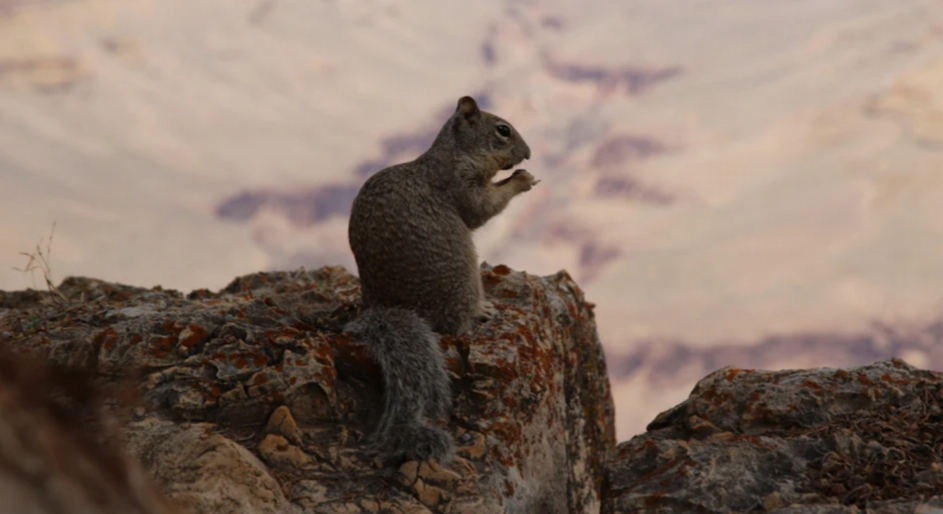Despite their ubiquity, squirrels have some fascinating traits and behaviors that might surprise you. Here are 14 playful facts about squirrels that highlight their incredible adaptations and unique qualities.
1. FAMOUS FOR HOARDING FOOD
Squirrels are famous for hoarding food, particularly nuts. But what’s truly remarkable is their ability to remember where they’ve buried these snacks. Squirrels use spatial memory, which helps them track the locations of hundreds or even thousands of food caches. This skill is so advanced that some squirrels even bury nuts in a way that prevents other animals from finding them, a tactic known as "deceptive caching." Squirrels inadvertently play a crucial role in reforestation and ecosystem health. When they bury nuts and seeds and forget to retrieve them, these caches often sprout into new plants and trees. This behavior, known as "scatter hoarding," contributes significantly to forest regeneration and biodiversity.
2. LEAP UP TO 10 TIMES THEIR BODY LENGTH
Squirrels are incredible jumpers. They can leap distances of up to 10 times their body length, which is essential for navigating trees and avoiding predators. Their powerful back legs and bushy tails act as stabilizers during these high-flying maneuvers. Whether it’s leaping across branches or escaping danger, squirrels’ agility is truly impressive.
3. TWO SETS OF INCISORS THAT NEVER STOP GROWING
Like other rodents, squirrels have four sharp incisors that grow constantly throughout their lives. To keep them from becoming too long, squirrels must gnaw on various objects, such as tree bark or nuts, to wear them down. If they didn’t, their teeth could grow too long and prevent them from eating. The front surface of a squirrel’s incisors is coated with a hard orange or yellow enamel, while the back surface is softer dentin. This differential structure causes the back to wear down faster, maintaining a sharp, chisel-like edge. Unlike human teeth, which have roots, squirrel incisors are "rootless," meaning they continue growing from the base.
4. COMMUNICATE USING WIDE RANGE OF SOUNDS
While you may not always hear squirrels talking, they do communicate using a wide range of sounds. These include high-pitched warning calls to alert other squirrels of danger, aggressive tail flicks to warn rivals, and even soft chattering sounds during social interactions. Each sound or gesture helps them convey different messages, from warning of predators to signaling distress.
5. SOME SQUIRRELS CAN "FLY" OVER 300 FEET
Flying squirrels don’t actually fly, but they can glide for astonishing distances—sometimes over 300 feet! They use a special membrane called the patagium, which stretches from their wrists to their ankles, allowing them to soar effortlessly between trees.
6. SOME SQUIRRELS CAN DETECT PREDATORS USING INFRARED VISION
Ground squirrels in certain regions have been found to detect infrared radiation, allowing them to sense predators like rattlesnakes, even in the dark. This superpower helps them avoid deadly encounters with stealthy predators.
7. FALL FROM GREAT HEIGHTS
Squirrels are known for their ability to survive falls from high places. Their small size, lightweight bodies, and bushy tails act as a parachute, slowing their descent and preventing injury. Squirrels can fall from heights of over 100 feet without breaking a bone, thanks to their unique anatomical adaptations. Their bones are less dense than those of larger mammals, which makes them more resistant to fractures. Squirrels instinctively aim to land on their feet, much like cats. Their strong, padded feet help absorb the shock of landing.
8. SQUIRRELS CAN "FAKE" BEING DISTRACTED
Squirrels have many natural predators, including hawks, snakes, foxes, and even domestic cats. In such a dangerous world, they need more than speed and agility to avoid becoming prey. Faking distraction is a tactic squirrels use to confuse potential threats or protect their valuable food caches.
When a predator is nearby, a squirrel may act as if it is preoccupied—grooming itself, digging aimlessly, or inspecting the ground. This behavior can lull the predator into thinking the squirrel is unaware of the danger. At the right moment, the squirrel can make a sudden escape, leaving the predator unprepared to strike.
9. THERE ARE OVER 200 SPECIES OF SQUIRRELS
Squirrels belong to the family Sciuridae, and there are more than 200 different species worldwide. These species range from the tiny, nocturnal flying squirrels to the larger tree squirrels and ground squirrels that are more familiar to us. Although they may look similar, each species has unique behaviors, habitats, and physical features adapted to its environment.
10. ROTATE THEIR ANKLES 180 DEGREES
One of the most extraordinary features of squirrels is their ability to rotate their hind ankles 180 degrees. This unique adaptation allows them to climb headfirst down trees and maneuver easily on vertical surfaces. It’s a skill few mammals possess, giving squirrels an edge in their arboreal lifestyles.
12. SQUIRRELS HAVE BUILT-IN UMBRELLAS.
Tree squirrels are equipped with bushy tails that serve multiple purposes, including acting as a shield against the elements. During rain or snow, squirrels can use their tails as a cover. Additionally, the tail provides balance, warmth, and a communication tool.
13. SOME SQUIRRELS ADOPT ORPHANED YOUNG.
Squirrels exhibit surprising levels of altruism. In certain cases, female squirrels have been observed adopting orphaned pups, especially if they share a genetic connection. This behavior increases the orphaned squirrel’s chance of survival and demonstrates the social complexity of these animals.
14. SQUIRRELS ARE RESPONSIBLE FOR THOUSANDS OF NEW TREES
Squirrels inadvertently play a crucial role in reforestation and ecosystem health. When they bury nuts and seeds and forget to retrieve them, these caches often sprout into new plants and trees. This behavior, known as "scatter hoarding," contributes significantly to forest regeneration and biodiversity.
---
Squirrels are far more than just cute, bushy-tailed creatures running around parks and backyards. Their remarkable abilities, from expert memory to incredible leaps, showcase the brilliance of nature’s design. Next time you see a squirrel, take a moment to appreciate its many hidden talents and quirks.








0 Comments